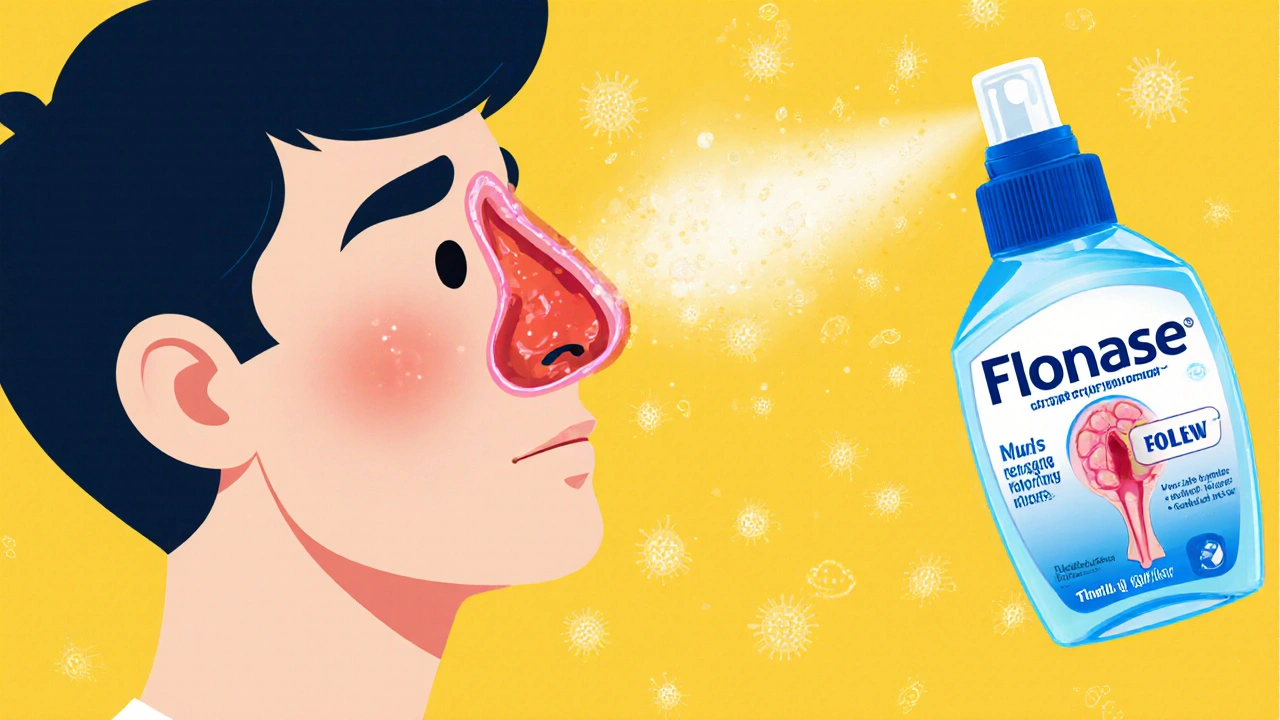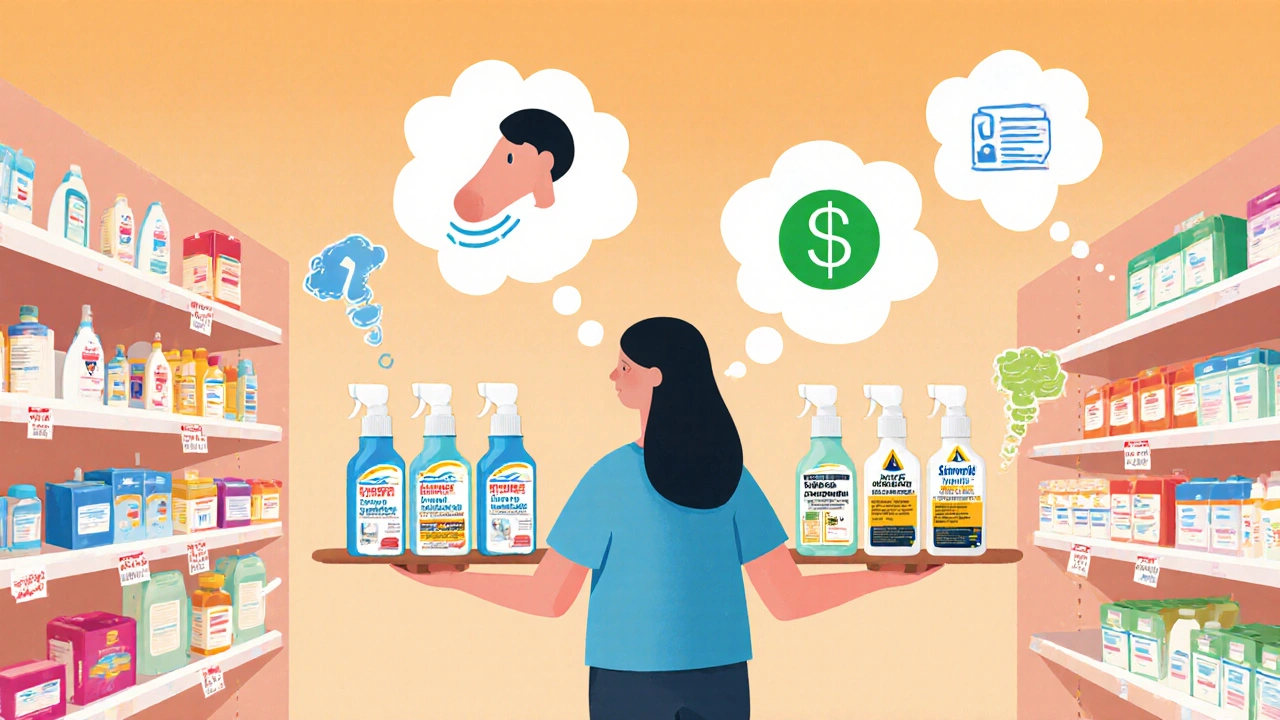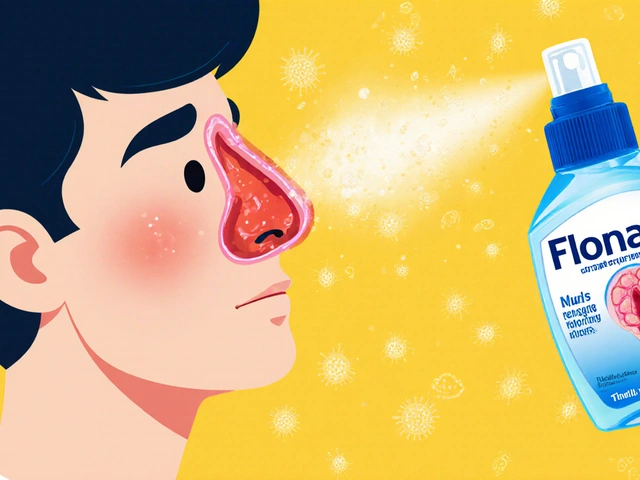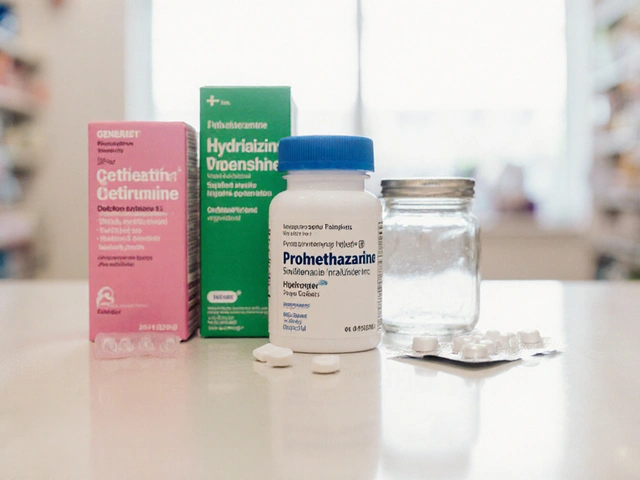16
Flonase vs Other Nasal Sprays: Fluticasone Comparison Guide 2025

Allergic rhinitis strikes millions every year, and most of us end up reaching for a nasal spray to clear the congestion. While Flonase (fluticasone propionate) dominates the shelves, there are several other options that promise similar relief with different trade‑offs. This guide walks you through the science, the costs, and the real‑world performance of Flonase and its main competitors so you can pick the spray that fits your lifestyle.
How Flonase Works
Flonase is a synthetic glucocorticoid formulated as a nasal spray. It binds to corticosteroid receptors in the nasal mucosa, suppressing the inflammatory cascade that causes swelling, itching, and excess mucus. By targeting inflammation directly at the source, Flonase reduces symptoms within 12‑24 hours and provides continuous relief when used twice daily.
Flonase Profile
- Active ingredient: Fluticasone propionate (50µg per spray)
- Drug class: Intranasal corticosteroid
- Availability: OTC in the U.S., prescription in some countries (including Australia)
- Typical dosage: 1-2 sprays per nostril once or twice daily (max 200µg/day)
- Onset of action: 12‑24hours for noticeable relief
- Duration of effect: Up to 24hours per dose
- Common side effects: Nasal irritation, dryness, occasional epistaxis; systemic effects are rare at recommended doses
- Price range (2025 US market): $15‑$25 for a 120‑spray bottle
Popular Alternatives
Below is a quick snapshot of the most widely used nasal sprays that compete with Flonase. Each has its own active molecule, regulatory status, and patient‑experience profile.
Nasacort contains triamcinolone acetonide, another intranasal corticosteroid with a slightly lower potency than fluticasone.
- OTC in the U.S.; prescription in many other markets
- Dosage: 1 spray per nostril once daily (55µg per spray)
- Onset: 8‑12hours
- Price: $12‑$20 for 120 sprays
Rhinocort (budesonide) offers a similar corticosteroid profile but is marketed as a prescription‑only product in most countries. Dymista combines azelastine (an antihistamine) with fluticasone, targeting both histamine‑mediated and inflammatory pathways. Beconase (beclomethasone dipropionate) is a prescription‑only steroid that some patients prefer for its low systemic absorption.
Side‑by‑Side Comparison
| Product | Active ingredient | Drug class | OTC / Prescription | Typical dose | Onset | Common side effects | Price (USD) |
|---|---|---|---|---|---|---|---|
| Flonase | Fluticasone propionate | Intranasal corticosteroid | OTC (US) | 1‑2 sprays/nostril BID | 12‑24h | Dryness, irritation, nosebleeds | $15‑$25 |
| Nasacort | Triamcinolone acetonide | Intranasal corticosteroid | OTC (US) | 1 spray/nostril QD | 8‑12h | Headache, mild irritation | $12‑$20 |
| Rhinocort | Budesonide | Intranasal corticosteroid | Prescription | 1 spray/nostril BID | 12‑24h | Throat irritation, cough | $18‑$30 |
| Dymista | Azelastine+Fluticasone | Antihistamine+corticosteroid | Prescription | 1 spray/nostril BID | 30‑60min (antihistamine) + 12h (steroid) | Bitterness, taste, dryness | $30‑$45 |
| Beconase | Beclomethasone dipropionate | Intranasal corticosteroid | Prescription | 1‑2 sprays/nostril BID | 12‑24h | Epistaxis, headache | $20‑$35 |
Pros and Cons of Each Spray
- Flonase - High potency, well‑studied safety record, OTC in the U.S.; may be pricier than generic steroids and can cause dryness if over‑used.
- Nasacort - Gentle on the nose, lower price, once‑daily dosing; slightly less potent, so some severe sufferers need a stronger spray.
- Rhinocort - Excellent for patients who need a prescription‑only product due to insurance coverage; can be harder to obtain without a doctor’s note.
- Dymista - Dual action tackles both histamine and inflammation; higher cost and a distinctive bitter taste that some dislike.
- Beconase - Low systemic absorption makes it a good choice for long‑term use; prescription‑only and modestly expensive.

How to Choose the Right Nasal Spray
- Severity of symptoms: Mild, occasional sneezing may be handled with Nasacort’s once‑daily regimen, while chronic congestion often needs the higher potency of Flonase or Dymista.
- Prescription vs OTC: If you prefer buying over the counter without a doctor’s visit, Flonase and Nasacort are the go‑to options. Insurance‑covered prescriptions can make Rhinocort or Beconase more affordable.
- Allergy profile: Patients who react strongly to histamine (e.g., itchy eyes, watery discharge) may benefit from the antihistamine component in Dymista.
- Cost sensitivity: Generic steroids like Nasacort and Rhinocort (when bought as a brand‑generic) keep monthly expenses under $20.
- Side‑effect tolerance: If you’ve experienced nosebleeds with a spray, consider a milder option like Nasacort or a prescription steroid with a lower systemic dose.
Ultimately, the best spray is the one you’ll use consistently. A short trial period (1‑2 weeks) of the chosen product, followed by symptom tracking, helps confirm the fit before committing long‑term.
Frequently Asked Questions
Can I use Flonase and Nasacort together?
Combining two intranasal steroids isn’t recommended because it raises the risk of systemic side effects. If one spray isn’t enough, talk to a doctor about stepping up the dose or switching to a combination product like Dymista.
How long does it take for Flonase to start working?
Most users notice reduced congestion within 12‑24hours, but maximum benefit often appears after 3‑5 days of consistent twice‑daily use.
Is Flonase safe for children?
Flonase is approved for children 4years and older in the U.S. The pediatric dose is usually 27µg per spray, once daily, and should be monitored by a pediatrician.
What should I do if I get a nosebleed from a nasal spray?
Stop the spray, gently pinch the soft part of the nose for 5‑10 minutes, and keep the nasal lining moist with saline spray. If bleeding recurs, consult a healthcare professional.
Do I need a prescription for Flonase in Australia?
Yes. In Australia Flonase remains a prescription‑only medication, so you’ll need a doctor’s script or an online pharmacy consultation to obtain it.
With the facts laid out, you can now match your symptoms, budget, and access preferences to the nasal spray that will give you the clearest breathing possible.









Matt Tait
October 16, 2025 AT 17:13Flonase is overpriced, just grab a generic steroid.
Benton Myers
October 16, 2025 AT 18:20I skimmed the guide and it honestly breaks down the options well. The table makes it easy to compare price and potency side by side. For most folks the OTC picks will do the job without breaking the bank.
Pat Mills
October 16, 2025 AT 19:26When it comes to choosing a nasal steroid, the chemistry behind each molecule matters more than the marketing hype.
Fluticasone propionate, the active ingredient in Flonase, binds tightly to glucocorticoid receptors, delivering a potent anti‑inflammatory punch with minimal systemic absorption.
Triamcinolone, found in Nasacort, is slightly less lipophilic, which translates to a marginally lower potency but also a softer nasal mucosa profile.
Budesonide, the star of Rhinocort, enjoys a reputation for rapid onset thanks to its high solubility, yet its prescription‑only status can be a barrier for some users.
The combination of azelastine and fluticasone in Dymista is clever because it tackles both histamine and inflammatory pathways simultaneously, offering relief within minutes for the antihistamine component.
However, the bitter taste and higher price point often make patients balk at staying consistent.
Beclomethasone dipropionate, marketed as Beconase, boasts an impressive safety record over long‑term use, but its requirement for a prescription limits accessibility.
Price differentials are not just about the sticker; insurance formularies, pharmacy discounts, and generic availability can swing the effective cost dramatically.
For a teenager with mild intermittent symptoms, a once‑daily Nasacort may be sufficient and easier to remember.
Conversely, an adult with chronic sinus inflammation might need the extra potency of twice‑daily Flonase or the dual action of Dymista.
Clinical guidelines generally recommend starting with the lowest effective dose to minimize side effects such as dryness or occasional epistaxis.
If nosebleeds occur, adding a saline rinse and pausing the steroid for a day often resolves the issue without abandoning therapy.
Switching between OTC options is safe as long as you allow a wash‑out period of about 24 hours to avoid cumulative corticosteroid exposure.
Patients with asthma should coordinate with their pulmonologist because intranasal steroids can have modest effects on lower airway inflammation.
Finally, remember that adherence beats potency; a half‑effective spray used faithfully will outperform a powerful one that sits on the shelf unused.
So weigh your symptom severity, budget, and convenience, then give the chosen spray a solid two‑week trial before deciding if you need to adjust.
neethu Sreenivas
October 16, 2025 AT 20:33I get why price matters 😔, but sometimes the OTC option saves a trip to the doctor. If you keep the spray moist with saline, the dryness drops.
Keli Richards
October 16, 2025 AT 21:40Flonase works but costs more
Ravikumar Padala
October 16, 2025 AT 22:46Honestly, the cost factor is only one piece of the puzzle and you can't ignore the dosing schedule.
People who forget a twice‑daily routine often end up with sub‑optimal control, which defeats the purpose of a high‑potency product.
Also, the mucosal side‑effects like dryness can be managed with a simple saline spray; there’s no need to abandon the medication altogether.
In my experience, the generic versions of triamcinolone provide comparable relief for mild cases without the extra price tag.
So weigh convenience, price, and your ability to stay consistent before writing off any option.
King Shayne I
October 16, 2025 AT 23:53Yo you cant just pick the cheapest one and hope it woks, you need to follow the dosing instrcutions.
jennifer jackson
October 17, 2025 AT 01:00Stay positive you’ll find the right spray 😊
Brenda Martinez
October 17, 2025 AT 02:06Optimism is great but it shouldn't blind you to the clinical data.
The guide makes it clear that Dymista’s dual action is only worth the extra cost for patients with severe histamine‑driven symptoms.
If you’re not in that category, you’re just paying for a bitter after‑taste.
Marlene Schanz
October 17, 2025 AT 03:13One thing to remember is that nasal sprays are only as good as the technique you use.
Tilting your head slightly forward and breathing in gently helps the medication coat the nasal lining more evenly.
Also, cleaning the nozzle weekly prevents bacterial buildup.
These little steps can make even a budget option feel effective.
Matthew Ulvik
October 17, 2025 AT 04:20Thanks for the tip! 👍 I’ll try the forward‑tilt method next time I use my spray.
Dharmendra Singh
October 17, 2025 AT 05:26From a cultural standpoint, many patients in South Asia rely on herbal nasal rinses before starting a steroid spray.
If you combine a saline rinse with the chosen medication, you respect traditional practices while still gaining modern therapeutic benefits.
Just be sure to discuss any complementary approaches with your doctor to avoid interactions.